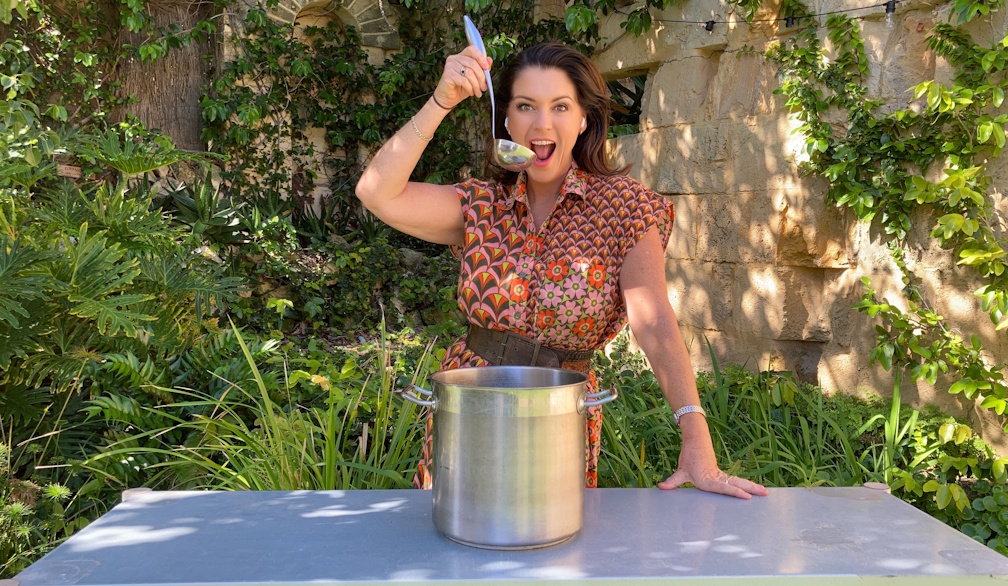An Interview with Penny Shaw
- Written by The Times

2025 was a huge year for Penny Shaw. The former Australia’s Got Talent finalist, starred in West Australian Opera’s The Pirates of Penzance, headlined two Fringe World Perth shows, Penny Shaw – Let’s Do it! And “1984 – Diary of a (teenage) Diva), performed at the Fremantle Biennale and was nominated for a Performing Arts WA Award for directing Freeze Frame Opera’s Don Giovanni. Now 2026 is already simmering to be another busy year for Penny; who is set to premiere her new show Penny’s Pot Luck Party at Fringe World Perth in January.
1. Who is Penny Shaw?
Some would say singer but I say, professional show-off, mother of four and South Fremantle enthusiast.
2. You're returning to Fringe World Perth - with a brand-new show, Penny's Pot Luck Party! Can you tell me about the inspiration behind the show and how it came about?
Penny’s Pot Luck Party will be organised chaos, with a pot full of musical numbers but with no idea what order they will be performed in. I did a similar show called Song Soup about 20 years ago now and I have wanted to revisit the concept ever since, but this time I have added in some guests for extra spice. The element of uncertainty and improvisation appeals to me. The work I do as an MC has convinced me that the most entertaining moments are often the spontaneous ones!
3. Speaking of potluck - what would you bring to a potluck party and why?
If I was to bring an edible dish to a party (not a song!) then lemon tart is always a winner. The lemons on my tree are sensational and I love baking.
3. If you were to host a potluck dinner party, who are three people you would invite (living or dead) and why?
That is a tricky one, I take my dinner parties very seriously. I love to entertain and I would need to make sure my guests would all get along with each other as well as with me. The first person that springs to mind is the late Dame Jilly Cooper who wrote, among many other things, Rivals which has recently become a huge hit for Disney. I spent a hilarious and booze filled night at her house in the 90s when she was writing a book about opera and wanted to interview a young singer and we corresponded up until her recent and unexpected death. She would be a dream guest, fun, full of gossip and outrageous.
I think she would get along with my next guest, Johanthan Bailey, recently voted the sexiest man alive and, more to the point, seems like he would be great company.
And finally I’d better ask my husband along, he’s a fabulous cook and would quietly load the dishwasher whilst Jilly and Jonathan recount stories of the rich and famous while we all scream with laughter.
4. It's been a big for you in addition to writing a new show - you presented two shows at this year's Fringe, starred in The Pirates of Penzance with West Australian Opera, have an upcoming Christmas at the Quarry with Freeze Frame Opera and you produce and present a weekly radio show - how do you manage to do it all and what keeps you inspired?
How do I manage? At one point in my life, I had four small children to contend with; now they are grown up everything else seems like a breeze! I am inspired by other people, by friends, family, things I read in the paper, people I interview, podcasts, music etc. I am always listening to something or someone.
5. You were recently nominated for a Performing Arts WA Award for Outstanding Direction, Movement Direction or Choreography for Don Giovanni - can you tell us about that experience and how directing differs to performing?
One of the reasons I love performing in opera, aside from the amazing music, is the process of getting inside the head of a character. I love working out why they act in the way that they do, what motivates them and how they relate to the other characters in the story. The most delightful thing about directing is that you get to do that for all the characters in the story, not just one. To take a classical masterpiece like Don Giovanni and bring it into the 21st Century (I set my production in 2017) was an absolute privilege. Seeing the show come together and being in the audience to really feel the response was amazing and quite different to being on the stage but equally satisfying.
6. Your career has taken you all over the world from performing in the UK, to national television on Australia's Got Talent to a principal artist at West Australian Opera and back again for Fringe - what is it you love most about performing back home in Perth?
I am really looking forward to not only being in Perth but basically in my own backyard! Terrace Greenhouse, where I am performing my show, is right in the heart of South Fremantle, which, if you are unfamiliar with the area, is bursting with gorgeous bars, pubs and restaurants. So, I am looking forward to being able to pop out for a drink and a nibble after the show and then wander home to see my dog.
7. Your show teases a few surprises - can you give us a clue as to what to expect?
No! That’s the point…the surprises will be for myself and my wonderful pianist, Tommaso Pollio, as much as for the audience. We don’t know exactly what is going to happen! Every night, I will have a number of guest performers in the audience, they too will have to wait and see when their number comes up and be prepared to jump in at any minute.
8. Your show promises a combination of opera, to jazz and musical theatre - is there a particular style that resonates with you and why?
A good song is a good song regardless of genre. My aim is to present a wide range of repertoire in my own particular style. Every song in this show means something to me, ideally each will be beautifully sung, delivered with honesty and there will be more than a little comedy.
9. What's your favourite thing about Fringe time?
I love the vibe of Perth and Fremantle in the summer generally, and during Fringe especially. Having more performing artists in town adds colour, sparkle and quite a lot of mischief.
10. Beyond potluck - what else are you cooking up in 2026?
To be honest 2026 is looking quite potluck at this point! A number of possibilities in the offing so we will just have to wait and see what gets pulled out of the pot. There will certainly be travel, some writing, more directing and of course more singing.
11. Is there anything else that you would like to add?
Please come along. And bring a friend or two. Remember you can stay home with Netflix for the rest of the year…don’t miss out on Fringe World!
Penny will be performing in Penny’s Pot Luck Party from January 29-31 at the Terrace Greenhouse in South Fremantle.
Click here to purchase your tickets. 










